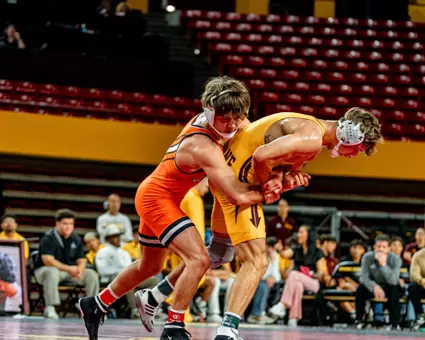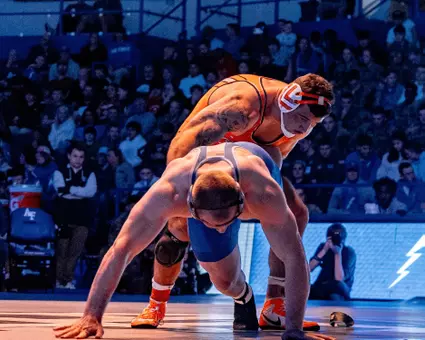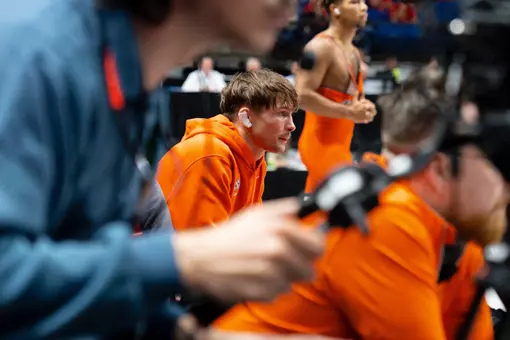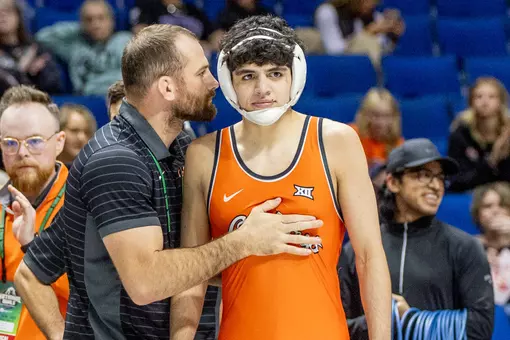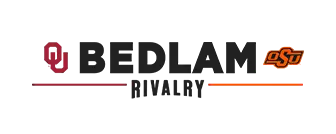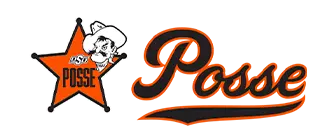Oklahoma State University Athletics
Wrestling Hall of Fame
August 23, 2006 | Cowboy Wrestling
PLEASE NOTE: All profiles were condensed from banquet programs used at each Hall of Fame member's induction. The original profiles were written by former Wrestling Hall of Fame Director Bob Dellinger except for one. The Dellinger summary was written by Bob's wife, Doris. Special thanks to both for their help. The Wrestling Hall of Fame is located on the corner of Hall of Fame and Duck streets, just east of Gallagher-Iba Arena.
David “Buddy” Arndt Wrestler 1940-42,46 Won every match in three years at Tulsa East Central High School and two state championships. (Missed one state meet because of illness) Captured his first NCAA 45-pound title as a sophomore at Oklahoma A&M in 1941 and placed second in the national freestyle tournament even though he won all of his matches in the meet. As a junior in 1942, swept NCAA and freestyle honors and earned the outstanding wrestler trophy in both tournaments, despite competing for the second straight year a full weight class above his normal weight to make room in the Aggie lineup for national champion Al Whitehurst. Interrupted his wrestling career for three years to fly a P-38 fighter in World War II and flew more than 100 combat missions over Italy. Returned to college after the war and won his third NCAA championship, this time at his natural weight of 136 pounds, and for the third time led the Aggies to the team trophy.Doug Blubaugh Wrestler 1955-57 Captured the 1960 Olympic gold medal at 160.5 pounds in Rome, defeating the previously unbeaten world champion from Iran. Won the 1957 NCAA title for Oklahoma A&M and earned outstanding wrestler recognition winning the national freestyle title the same year. Also won the national open freestyle tournament in 1959, the same year he became the second Blubaugh to win a gold medal in the Pan American games. Older brother Jack won the Pan Am gold in 1955. During his wrestling career, won more than 400 matches and lost only 17. Over four years of freestyle competition met college teammate Phil Kinyon 13 times, tying 12 times and winning only once in the final 1960 Olympic trials. After retiring from competition, turned to coaching. Coached both the U.S. Pan American and World Championship freestyle teams in 1971 while a graduate assistant coach at Michigan State. In 1972, became head coach at the University of Indiana.
Conrad Caldwell Wrestler 1929-31 Had never seen the sport of wrestling until enrolling at Oklahoma A&M, where coach Edward C. Gallagher recruited him from a gym class. Had only wrestled in two matches as a substitute heavyweight before winning three straight 165-pound bouts to clinch the 1929 NCAA title. Repeated in 1930 and 1931 at 175 pounds to become only the third wrestler ever to win three collegiate crowns. Moved to California in 1932 and competed five years for the Los Angeles Athletic Club. Only defeat of his career was in the 1932 Olympic trials in the first round. Came back to win those trials at 191 pounds, but another wrestler was chosen to compete in the Los Angeles Olympic Games. During 1936, was unbeaten from 174 pounds through heavyweight. In one 1933 dual meet against UCLA, weighed in at 174, but found his teammates at 191 and heavyweight were absent. Pinned the UCLA 174-pounder, decisioned the 191-pounder and, after a 10-minute struggle, pinned the heavyweight.
Tommy Chesbro Wrestler/Coach 1955-57/1970-84 When he returned to Oklahoma State University as only its fourth head wrestling coach, Tommy Chesbro followed a trail lazed by not one, but three, Hall of Famers. But in 15 years with the Cowboy reins, Chesbro eclipsed the victory totals of all three of his illustrious predecessors. From 1970 through 1984, his teams won 227 dual meets against only 26 defeats, a 90-percent winning record. He closed his coaching career with a 43-match winning streak, including 22 victories in 1983. During that season, the Cowboys shut out ten opponents, one of those foes posting the rare score of minus-1, thanks to a penalty against its coach. Chesbro's Cowboys won the NCAA team championship in 1971 and placed among the top four teams a dozen more times. He coached 20 individual NCAA champions and 20 national AAU and USA Wrestling titlists, headed by World and Olympic champions Kenny Monday and John Smith and three-time NCAA heavyweight king Jimmy Jackson. Chesbro was a state high school champion wrestler and a starter on Oklahoma State's 1959 NCAA championship team. In eight years as a high school coach, he had a record of 51-23-8, bringing his victory total to 278. His teams won one state title and twice were runners-up.
Kendall Cross Wrestler 1987-90 It has been said on several occasions that Kendall Cross was destined to be an Olympic Champion. But to realize that prediction would take on of the most wide-open, exciting styles of competition ever seen in American wrestling ... the Kendall cross style. After completing his high school career in Mustang, Okla., by winning a state championship, Kendall went on to Oklahoma State where he became a three-time All-American and the 1989 NCAA Champion. His first success at the International level came in 1988 when he became the Espoir World Cup Champion, setting the stage for his pursuit of Olympic Gold. In 1992, he was the only freestyle wrestler on the U.S. Olympic team not ranked number one at his weight at the beginning of the year. He finished sixth at the 1992 Barcelona Olympic Games. The road to the Olympic Gold would be no easier in 1996. His championship series with Terry Brands at the Olympic trials in Spokane, Wash., treated American fans to one of the most spectacular desplays of wrestling ever seen in the country. His victory at the trials sent him on to the Atlanta Olympic Games, where his dominating effort provided one of the most inspiring Gold Medal performances in memory. In 1997, he was named the USA Wrestling Athlete of the Year, while in 1992 and 1995 he was declared the Outstanding Freestyle Wrestler at the U.S. Nationals where he became a three-time National Champion. Although Kendall has moved on to a professional career as a financial consultant for Merrill Lynch of Boston, he continues to be a role model for young wrestlers and an impressive representative of our port. He has developed the Kendal Cross Gold Medal Wrestling club in the Boston area, designed to aid in the development of young aspiring wrestlers.
Fendley Collins Wrestler 1925-27 Was undefeated as a 175-pound wrestler under Edward C. Gallagher at Oklahoma A&M, winning the Canadian amateur championship in 1926 and the U.S. national amateur title in 1927. But his major contributions to the sport were as a coach, not as a competitor. Coached high school wrestling for two years before moving up to the college ranks as head coach at Michigan State in 1930. Guided the Spartans to 158 victories against 84 losses and 11 ties. Three times led his team to runner-up finishes in the NCAA Tourney, and his teams won 28 national titles in collegiate and amateur meets. Served on national rules and officials' committees and on USOC. Coached the U.S. teamin the 1955 Pan American Games and managed the 1964 Olympic team. G Gene Davis Wrestler 1964-67 Won the 1966 137-pound NCAA championship for Oklahoma State, but his biggest contributions to the sport of wrestling may had occurred following graduation, working with Athletes-in- Action. Was undefeated in 66 matches for Missoula (Mont.) High School and won four state championships. Came to OSU and was a three-time All-American with a 66-3-1 record and was Outstanding Wrestler in the Big Eight. After graduation, joined Athletes in Action, and in 11 years, won four national freestyle championships, placed both fourth and sixth in the World Championships, and competed in two Olympics, earning a bronze medal in 1976 despite weight cuts to 136.5 from 149.5. As coach of AIA, led his teams to 188 wins in 224 dual meets and has used the forum of athletics to spread the word of Christ. Coached the U.S. to a sweep of 10 gold medals in the 1979 Pan American Games and coached the world team in 1981.
Bob Dellinger Writer/Public Address Never stepped on the mat or coached at Oklahoma State, but when the Gallagher-Iba Arena P.A. rang out with “Ladies and gentleman welcome to history — the Bedlam Series” it was his voice that filled the arena. The real imprint on the sport came as a newspaper reporter and in the field of tournament operations. He covered wrestling, both state high school and national collegiate, as a major sport for the daily newspaper in Oklahoma City. In 1960, won the Amateur Wrestling News award for “Writerof the Year”. After winning the trophy again in 1961 and 1962, withdrew his name from competition and the award was renamed in his honor. Became the leading authority on seeding and bracketing and all other aspects of tournament planning, and authored two revolutionary rules, the present-day team scoring system in 1959 and the current consolation bracketing in 1971. Has participated in operations of more than 100 national and international events, most in a position of primary responsibility. Dellinger passed away following the 1999 collegiate wrestling season.
Bobby Douglas Wrestler 1964-65 Bobby emerged on the national scene as a 1962 NAIA champion for West Liberty State. A year later, reached the NCAA finals, and his 13-8 battle with the defending champion from a much larger school was a classic. Bobby transferred to Oklahoma State, where he won the Big Eight title but was knocked out of the 1965 nationals by an injury, closing his collegiate career at 72-2. He won three national freestyle titles and represented the United States on two Olympic teams and six world teams. He placed second in the world in 1966, third in 1970 and fourth in 1969 andhe was fourth in the 1964 Olympic Games. He was captain of the1968 Olympic team and compiled a career record of 303 victories with only 17 defeats. After serving as assistant coach at Oklahoma State, Iowa State, and Cornell, he took the reins at the University of California at Santa Barbara in 1973. A year later, he moved to Arizona State, where he not only built a collegiate powerhouse, but also launched the Sunkist Kids club toward a series of national championships. He has been assistant coach for seven world and three Olympic teams and was the World Cup coach for 1987. Bobby Douglas was the first black athlete to wrestle for the USA in the Olympic Games, the first to captain our Olympic team, and the first to coach wrestling at a major university. He showed, by example, that others could reach such goals.
Ross Flood Wrestler 1933-34 Was undefeated in 30 matches at 126 pounds, winning NCAA championships in 1933, 1934, and 1935 and each time leading the Aggies to the national team title. As a senior, won outstanding wrestler honors at the national tournament. Won national freestyle championship in 1935 and 1936 and claimed another outstanding wrestler trophy. Earned a spot on the U.S. Olympic Team and captured the silver medal at 123 pounds in the Berlin Games. Also won the gold medal at the 1937 Pan American Exposition in Dallas, defeating three other national champions despite severe rib injuries which brought an end to his competitive career. Coached for six years at Stillwater High School before entering the Navy and spending five years as a physical instructor. Returned to coaching in 1946 at Southwestern Oklahoma State.
Edward C. Gallagher Coach 1916-40 Started Oklahoma State on its road to greatness in the sport of wrestling. As an athlete earned recognition in track and football, but as a coach excelled in the sport of wrestling. Put his first Aggie varsity wrestling team on the mat in 1916, the same year became director of athletics. Applied engineering knowledge of leverage and stress to the development of more than 300 wrestling holds. Was the first to organize systematic practices and paid close attention to diet and training methods. In 23 years of coaching, produced 19 undefeated teams. Won 138 dual meets with five losses and four ties, and before 1932 won 68 consecutive meets. In the first NCAA Tournament in 1928, fourA&M wrestlers out of seven possibilities won individual titles to clinch the first national collegiate team title. Coached in 13 NCAA Tournaments, winning 10 and tying for first in the 11th. Guided 37 individual NCAA champs, 32 national amateur titleholders and three Olympic gold medalists.
Art Griffith Coach 1941-56 Succeeded Gallagher as Oklahoma A&M head coach and continued the Aggie dynasty in the sport of wrestling. Started his coaching career at Tulsa's Central High School, where his teams won 94 of 100 matches, including 50 in a row, and 10 Oklahoma scholastic championships. Teams were undefeated 12 times, and won the only two national high school tournaments ever conducted. Took over from Gallagher in 1941 and fashioned eight NCAA championships in 13 attempts. Guided his teams to 78 victories, four ties and seven losses, and 10 times his teams were undefeated. Led individual wrestlers to 27 NCAA titles. Extended Aggie winning streak from 27 to 76 consecutive wins without a loss. Coached the 1948 U.S. Olympic team. Developed the point scoring system for wrestling bouts which before had been determined only by falls or time advantage. Coached all but two of the 16 1941 NCAA finalists either in high school or college.
Stanley Henson Wrestler 1936-38 Wrestled two years for Art Griffith at Tulsa's Central High School, winning two state championships and the outstanding wrestler award as a senior. Came to Oklahoma A&M to wrestle for E.C. Gallagher and lost only one time in three seasons. Won three NCAA championships and led the Aggies to the team championships each of those three years. Was honored as the national tournament's outstanding wrestler as a sophomore. Won the 1937 Pan American Exposition and in 1938, in addition to winning the NCAA title, also won the national freestyle crown. In a fall during his senior year, suffered a severe shoulder injury that hampered but could not prevent a third NCAA championship. Spent five years as a physical instructor and wrestling assistant at the U.S. Naval Academy, then completed a degree in medicine at the University of Maryland in 1950.
Jess Hoke Publisher Never wrestled or coached at Oklahoma A&M but became interested in wrestling during his days as a student sportswriter in the early years of Gallagher's Aggie coaching career. Wrote the account of the first major A&M victory, over Nebraska in 1920. When five of seven sons traveled north to wrestle for Fendley Collins at Michigan State, discovered that results from matches that far away were hard to come by. Founded Wrestling News and Reports, which eventually became Amateur Wrestling News and published thousands of dual meet summaries and complete reports on wrestling from high school tournaments to the Olympic Games. As editor of AWN, inaugurated many projects to stimulate interest throughout the sport, such as national rankings of college teams and individuals, tournament forecasts and achievement awards to coaches, wrestlers, writers, photographers and other contributors.
Richard Hutton Wrestler 1947-50 Has an imposing physical specimen striding across the Oklahoma prairie. And Dick Hutton reigned over the nation's collegiate heavyweights like few men before or since. He was the cornerstone upon which Coach Art Griffith rebuilt the Oklahoma A&M program when wrestling resumed after World War II. Hutton suffered only one loss and one draw in four years of varsity competition. That one defeat, a controversial referee's decision in the 1949 NCAA finals against light-heavyweight champion Verne Gagne, kept Hutton from becoming the sport's first four-time collegiate king. He won titles in 1947, 1948 and 1950, and was a member of two national championship teams. His four appearances in the national finals–three of them successful–established a record that was unmatched for 28 years and unbroken until 44 years later. Hutton placed sixth in the 1948 Olympic Games after being slowed by an injury in his second bout. After five years in the U.S. Army, he competed 10 years in professional wrestling, winning the heavyweight belt from Lou Thesz in 1957 and holding it for two years. Contrary to the usual professional image, he became known for his honest, gimmick-free wrestling. In later years, Hutton has owned and operated a thoroughbred and quarterhorse racing and breeding ranch in Texas.
Cliff Keen Wrestler 1923-24 Was an undefeated wrestler under Edward C. Gallagher and won the Missouri Valley national invitational championship. Won the 1924 Olympic trials, but was unable to compete because of a broken rib. After graduation, turned sights to coaching first as high school football coach, then as head wrestling coach at the University of Michigan. In 45 years, led Wolverines to two NCAA runner-up finishes and 13 Big Ten Conference championships. Finished in the top three in the conference 40 times. Won 276 dual meets, lost 88 and tied 11. Guided individuals to 11 NCAA titles and 81 conference crowns. Served on the U.S. Olympic Committee from 1928 to 1952 and was manager of the 1948 Olympic team. Was an original member and later president of the National Wrestling Coaches Association and presided over the national rules committee. Has pioneered the development of safe, effective wrestling equipment.
Paul Keen Coach 1922 Attended school at Oklahoma A&M but never wrestled there. Was a standout in football, basketball and track. Learned the fundamentals of wrestling by working out with Gallagher's teams and could have wrestled on the varsity as a senior but had been elected captain of the basketball team. After graduation, joined the coaching staff at the University of Oklahoma with the task of building the Sooners into a wrestling power similar to his alma mater. In 1932, after four years at the Sooner helm, led his team to an outstanding upset of Gallagher's Aggies in Stillwater, abruptly ending a winning streak that had spanned 70 dual meets and 10 undefeated seasons. In 1936, guided OU to the NCAA title, the Sooners first national championship in any sport. Also finished second twice and third twice in the NCAA, and crowned 12 individual champions. Wrestlers won six titles in the Big Six Conference and never placed below third. Was slated to be the 1940 Olympic coach until World War II wiped out the Games. Worked with Gallagher to establish a strong high school program in Oklahoma.
Frank Lewis Wrestler 1933-35 After winning one state high school championship and earning medals in three more, planned to retire from wrestling and concentrate on studying in college. Needed a physical education credit and enrolled in a wrestling class to make easy grade. As part of the class, was required to enter the all-college intramural tournament. Failed to win the intramural championship which spurred him back to concentrating on wrestling. Didn't have the stamina to wrestle the longer college matches and, because of a minor heart condition, his coach had to devise a special training routine to build stamina without straining his health. Nonetheless, fashioned a 45-5 collegiate record placing second in1934 NCAA Tournament and winning the title in 1935. Won the 1935 national freestyle title and won a gold watch as the first contestant recognized as outstanding wrestler. Was undefeated in the 1936 Olympic trials and won four matches against one loss in the Games to claim the gold medal at 158.5 pounds. Guy Lookabaugh Wrestler 1921-25 Was a two-sport star at Oklahoma A&M. Enrolled in 1917 and immediately became a football hero, but left school for the Army and World War I. Returned in 1920 and helped A&M beat a Nebraska team that had been undefeated for five years. Aggies were trailing when he took the mat at 158 pounds and battled through a 27-minute overtime match for a difficult decision. Wrestled again in the 175-pound bout, defeating the Cornhuskers' unbeaten star in a regular 21-minute match. Never won a national collegiate title because there were none, but won championships of three conferences—the Missouri Valley (now the Big Eight), the Western (Big Ten) and the Southwest. Turned to coaching in 1922 and 1923, but returned to school to train for the 1924 Olympics. Reached the finals in Paris Games, but lost an unpopular split-decision. After graduation in 1925, coached three years at Kansas, and served on the national rules committee formulating plans for the first NCAA Tournament. Coaching career continued at Northeastern Oklahoma and Grinnell of Iowa until 1940.
Earl McCready Wrestler 1928-30 Wrestled in the first three NCAA championships in 1928, 1929 and 1930, and became the first three-time champion in collegiate history. Came to Oklahoma A&M in 1926 after Fendley Collins and two teammates from the school spotted the strapping heavyweight at the Canadian national freestyle tournament and persuaded him to follow them back to their campus. Under coach Edward C. Gallagher, he won every match for three years, all but three by fall. In the 1928 finals, he won by a fall in 19 seconds, still a record for an NCAA Tournament conducted under collegiate rules. Also won four national freestyle championships, one in the U.S. and three in Canada. Represented Canada in the 1928 Olympics, carrying his country's flag in the opening ceremonies. Won a gold medal in the 1930 British Empire Games. As a collegiate athlete, was a three-year letterman and won all-star honors at guard. Wrestled professionally for 28 years, including a match in the famed Royal Albert Hall in London.
Joe McDaniel Wrestler 1936-38 Won three NCAA titles for Oklahoma A&M, leading the Aggies of coach E.C. Gallagher to the team trophy all three times. As a 118-pound junior, was voted Outstanding Wrestler of the 1938 NCAA tournament. Was also a three-time national freestyle champion, twice as a collegian when the Aggies also won team honors, and again in 1941, two years after graduation. Competed internationally at the close of his junior year in a 1938 European tour climaxed by a tournament at Stockholm, Sweden. Was undefeated in 12 bouts and scored an overwhelming victory over the winner of the Olympic gold two years earlier. Missed his chance at an Olympic title because of World War II. After a year of high school coaching and another at Maryland, returned from the war to coach 11 years at Syracuse University, leading the Orangemen to a fourth-place national finish. In 1963, moved to Wyoming, coaching two years in high school and eight at the University. In 1973, returned to his hometown of Sulphur, Okla., where he continues to serve as the high school coach.
Kenny Monday Wrestler 1981-84 No matter what the calendar said, when he stepped onto a mat it was always “Mon-day Night!” Poise, patience and mental toughness propelled Kenny Monay to Olympic Gold in 1988, Silver in 1992 and sixth in 1996. He made winning a habit and wrestling a pleasure to watch. At Booker T. Washington, Kenny's coach characterized his pasage from “scrawny to awesome,” as Monday chalked up an almost unblemished record of 140-0-1. He amassed four state high school championships at four different weights, tucking in a 1977 Junior Nationals title along the way. In seven trips to the Junior Olympics, he won five times. At Oklahoma State, the 150-pounder became a teammate of the only wrestler to tie him in high school duals, a fierce competitor named Mike Sheets. At OSU, Kenny ran up a career record of 121-12-2. Twice a runner-up, Monday captured an NCAA title in 1984. he ranked second on OSU's all-time list for falls. In 1986, he won the National Wrestling Hall of Fame Classic and took both the Sunkist International Open and the World Cup the following year. International victories came at the 1988 Tblisi Tournament, the 1989 World Cup Championships, the 1991 Pan American Games and the President's Cup in Turkey, the 1992 Roger Coulon in France and the 1996 Dan Kolov Tournament in Bulgaria. At the grueling Tblisi in Soviet Georgia, he was honored witht he prized animal-skin cloak as the outstanding wrestler. One American coach summed up the Tblisi as “probably five times as tough” as the Olympics. O.W. honors also went to Kenny in 1989 and 1990 at the Grand Masters tournament. Four times Kenny posted wins at the U.S. National Championships and also captured the 1989 U.S. Olympic Festival crown. His 1988 Olympic Games success brought Monday the USA Wrestling Athlete of the Year award, as well as the Amateur Wrestling News Man of the Year in 1989.
Bobby Pearce Wrestler 1929-31 Suffered with allergies as a youngster and took up wrestling to make himself physically stronger. As a prepster, was allowed to join the Cushing High School team, despite the coach's misgivings. Won three state championships and fashioned three undefeated seasons. As a high school senior, reached the semifinals of the 1928 Olympic trials. As a collegiate wrestler, won 60 matches, lost four and tied one. Liked to go for the quick fall and once flattened an opponent in just 11 seconds. Won national freestyle championships in 1930 and 1931 and clinched the NCAA title in 1931 and was runner-up in 1932. Won the gold medal in the 1932 Olympics at Los Angeles, becoming the first Oklahoma wrestler ever to do so. Although only a 126-pounder, competed professionally for five years and coached at the same time. Led Cushing to the state title in 1933 and coached a YMCA team. Left coaching, but returned to it 20 years later and led Mesa College to two undefeated seasons and a conference championship.
Rex Peery Wrestler 1933-35 Earned three NCAA titles at Oklahoma A&M under coach Edward C. Gallagher. For the next 29 years, established a great coaching career, 13 years in Oklahoma high schools and 16 years at the University of Pittsburgh. In 1952, 1953 and 1954, coached his elder son, Hugh, to NCAA championships. In 1955, 1956 and 1957, coached his younger son, Ed, to the those same honors. As a wrestler, was undefeated in dual meets. Won the 1935 national amateur championship also. As a coach, produced 233 victories, 58 losses and six ties. Coached Pittsburgh teams to two NCAA runner-up finishes and produced 13 individual collegiate champions and 23 Eastern champions. Coached the U.S. freestyle team in the 1964 Tokyo Olympics and was a member of the U.S. Olympic Committee for 12 years. Was founder of the United States Wrestling Federation programs in Pennsylvania and serves on the board of governors of the National Wresting Hall of Fame.
Grady Peninger Wrestler 1949-50 Only once, in more than 30 years, has the national collegiate team championship escaped from the state of Oklahoma and Iowa. And it took a native Oklahoman, Grady Peninger, to carry the trophy away to Michigan State. He reached national prominence while still in high school in Tulsa, winning the state championship and the first two national freestyle crowns during his senior year of 1945. After a two-year hitch in the Navy, he enrolled at Oklahoma A&M, placing as an Olympic alternate in 1948 and as an NCAA finalist a year later. In 1960, he was called by Michigan State to assist, and soon to succeed, Fendley Collins at the helm of the Spartans. Peninger's team dominated the Big Ten Conference, winning seven consecutive titles starting in 1966. He was voted National Coach of the Year after the 1967 triumph. In all, he produced 43 conference and 11 national champions, 90 Big Ten medalists and 46 All-Americans. His Spartans won 213 of 330 dual meets and enjoyed 23 consecutive winning seasons. He was the first coach to bring a team to Oklahoma, wrestle both the Cowboys and the Sooners, and go home undefeated. Peninger was president of the National Wrestling Coaches Association, which elected him a lifetime member. While serving on the NCAA Committee, he pushed through the expanded consolation bracket adopted in 1986, creating more opportunity for the wrestlers.
Myron Roderick Wrestler/Coach 1953-69 In three years as a wrestler at Oklahoma A&M, won 42-of-44 matches and three NCAA titles, one at 137 pounds and two more at 130. Placed fourth in the 1956 Olympic Games at Melbourne, losing a split decision to the eventual champion. Returned from the Olympics to find he had been named head wrestling coach at Oklahoma A&M, just one season after winning his last NCAA Championship. In 1958, led the Oklahoma State Cowboys to the NCAA team title and was the youngest coach ever to guide a national championship team in any sport. In 13 years of coaching, produced seven NCAA championships and a dual record of 140-10-7. Put together one streak of 84 consecutive duals without a loss. Guided wrestlers to 20 individual NCAA titles and four gold medals as the U.S. coach in the 1963 World Games and was assistant in the 1964 Olympics.
Joe Seay Coach 1985-91 After leading his teams at Cal State-Bakersfield and Oklahoma State to a total of nine NCAA championships, Joe Seay then coached the USA to milestone victories in the Goodwill Games, World Championships and Olympic Games. A 1964 graduate of Kansas State, Seay wrestled there three years and later won three national Greco-Roman titles while placing second twice in freestyle. But it was as a coach at all levels thate he earned lasting renown. Starting with eight years at Bakersfield South High in California, he compiled a record of 177-12-2 and was national high school coach of the year. Moving across town to Cal State, he coached a dozen years and won seven Division II national championships with a record of 189-56-2. At Oklahoma State, from 1985 to ‘92, he went 114-8-2 with back-to-back Division I crowns in 1989 and “90. His folkstyle record adds up to 480 victories and an .859 winning percentage. He is the only coach to win collegiate team titles in both divisions, and he was named national coach of the year five times. When his college coaching career ended in 1992, Seay quickly stepped into a major role in the international scene. Already closely affiliated with the Sunkist Kids program, he became their head coach and continued the club's still unbroken streak of national freestyle championships. He coached the USA to its first-ever Senior World freestyle championship in 1993 and repeated two years later, also leading a Pan American Games victory in 1995. And at the Centennial Olympics in Atlanta, Seay's wrestlers won the medal count.


